1. An object is placed on the principal axis of a concave mirror of focal length 10 cm at a distance of 8.0 cm from the pole. Find the position and the nature of the image.
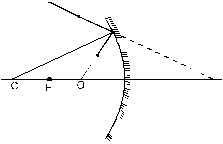
Sol. 
The positive sign shows that the image is formed at 40 cm from the pole on the other side of the mirror (figure). As the image is formed beyond the mirror, the reflected rays do not intersect, the image is thus virtual.
2. A rod of length 10 cm lies along the principal axis of a concave mirror of focal length 10 cm in such a way that the end closer to the pole is 20 cm away from it. Find the length of the image.
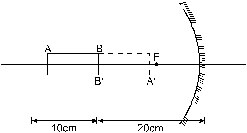
Sol. The situation is shown in figure. The radius of curvature of the mirror is r = 2f = 20 cm. Thus, the nearer end B of the rod Ab is at the centre of the curvature and hence, its image will be formed at B itself. We shall now located the image of A.
Here u = – 30 cm and f = – 10 cm. We have
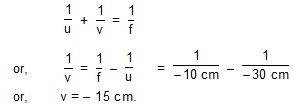
Thus, the image of A is formed at 15 cm from the pole.
The length of the image is, therefore, 5.0 cm.
3. At what distance from a convex mirror of focal length 2.5 m should a boy stands so that his image has a height equal to half the original height? The principal axis is perpendicular to the height.
Sol. We have,

Thus, he should stand at a distance of 2.5 m from the mirror.
4. A 2.0 cm high object is placed on the principal axis of a concave mirror at a distance of 12 cm from the pole. If the image is inverted, real and 5.0 cm high, find the location of the image and the focal length of the mirror.
Sol. .jpg)
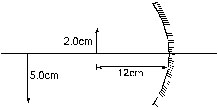
The image is formed at 30 cm from the pole on the side of the object. We have,
.jpg)
![]()
5. Consider the situation shown in figure. Find the maximum angle q for which the light suffers total internal reflection at the vertical surface.
Sol. The critical angle for this case is
.jpg)
.jpg)
If q¢¢ is greater than the critical angle, q will be smaller than this value. Thus, the maximum value of q, for which total reflection takes place at the vertical surface, is sin–1 (3/4).
6. A right prism is to be made by selecting a proper material and the angles A and B (B < A), as shown in figure. It is desired that a ray of light incident normally on AB emerges parallel to the incident direction after two internal reflections. (a) What should be the minimum refractive index µ for this to be possible? (b) For µ = 5/3, is it possible to achieve this with the angle A equal to 60 degrees?
Sol. .jpg)
.jpg)
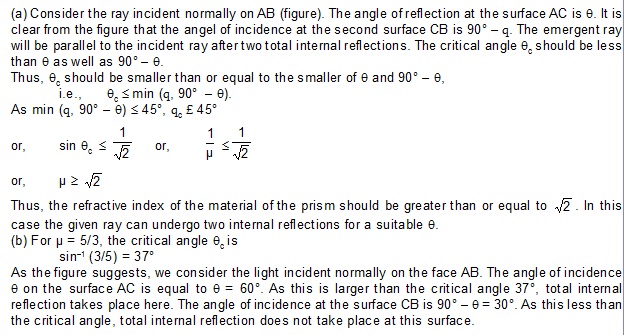
7. A point object O is placed in front of a transparent slab at a distance x from its closer surface. It is seen from the other side of the slab by the light incident nearly normally to the slab. The thickness of the slab is t and its refractive index is µ. Show that the apparent shift in the position of the object is independent of x and find its value.
Sol. The situation is shown in figure. Because of the refraction at the first surface, the image of O is formed at O1. For this refraction, the real depth is AO = x and the apparent depth is AO1. Also the first medium is air and the second is the slab. Thus,
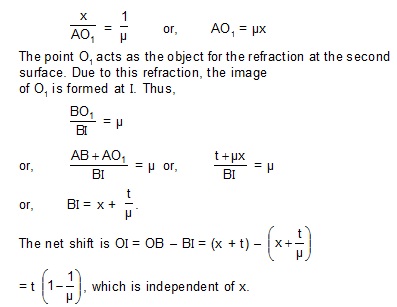
.jpg)
8. Consider the situation shown in figure. A plane mirror is fixed at a height h above the bottom of a beaker containing water (refractive index µ) upto a height d. Find the position of the image of the bottom formed by the mirror.
Sol. 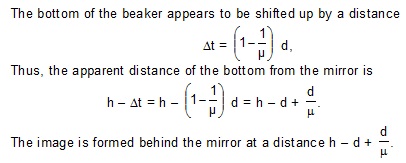
9.
Sol. 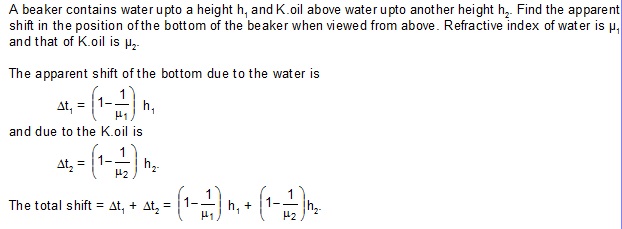 .
.
10. Monochromatic light is incident on the plane interface AB between two media of refractive indices µ1 and µ2 (µ2 > µ1) at an angle of incidence q as shown in figure. The angle q is infinitesimally greater than the critical angle for the two media so that total internal reflection takes place. Now, if a transparent slab DEFG of uniform thickness and of refractive index µ3 is introduced on the interface (as shown in the figure), show that for any value of µ3 all light will ultimately be reflected back into medium II.
Sol. 
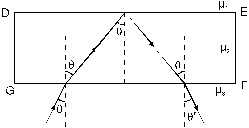
.jpg)
As the slab has parallel faces, the angle of refraction at the face FG is equal to the angle of incidence at the face DE. Equation (ii) shows that this angle is infinitesimally greater than the critical angle here. Hence, the light suffers total internal reflection and falls at the surface FG at an angle of incidence q¢. At this face, it will refract into medium II and the angle of refraction will be q as shown by equation (i). Thus, the total light energy is ultimately reflected back into medium II.
11. A concave mirror of radius 40 cm lies on a horizontal table and water is filled in it up to a height of 5.00 cm (figure). A small dust particle floats on the water surface at a point P vertically above the point of contact of the mirror with the table. Located the image of the dust particles as seen from a point directly above it. The refractive index of water is 1.33.
Sol. The ray diagram is shown in figure. Let use first locate the image formed by the concave mirror. Let us take vertically upward as the negative axis. The R = – 40 cm. The object distance is u = – 5 cm. Using the mirror equation,
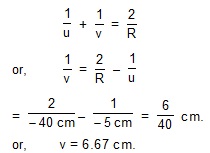
.jpg)
The positive sign shows that the image P1 is formed below the mirror and hence, it is virtual. These reflected rays are refracted at the water surface and go to the observer. The depth of the point P1 from the surface is 6.67 cm + 5.00 cm = 11.67 cm. Due to refraction at the water surface, the image P1 will be shifted above by a distance
![]()
Thus, the final image is formed at a point (11.67 – 2.92) cm = 8.75 cm below the water surface.
12. An object is placed 21 cm in front of a concave mirror of radius of curvature 20 cm. A glass slab of thickness 3 cm and refractive index 1.5 is placed close to the mirror in the space between the object and the mirror. Find the position of the final image formed. The distance of the nearer surface of the slab from the mirror is 10 cm.
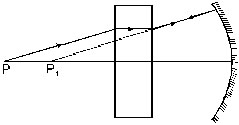
Sol. The situation is shown in figure. Because of the refraction at the two surfaces of the slab, the image of the object P is formed at P1, shifted towards the mirror by a distance
![]()
Thus, the rays falling on the concave mirror are diverging from P1 which is at 21 cm – 1 cm = 20 cm from the mirror. But the radius of curvature is also 20 cm, hence P1 is at the centre. The rays, therefore, fall normally on the mirror and hence, retrace their path. The final image is formed at P itself.
13. The refractive indices of silicate flint glass for wavelengths 400 nm and 700 nm are 1.66 and 1.61 respectively. Find the minimum angles of deviation of an equilateral prism made of this glass for light of wavelengths 400 nm and 700 nm.
Sol. 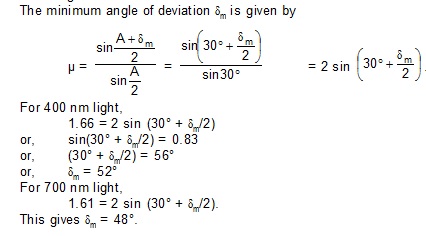
14. Consider the situation shown in figure. Light from a point source S is made parallel by a convex lens L. The beam travels horizontal and falls on an 88°-88°-4° prism as shown in the figure. It passes through the prism symmetrically. The transmitted light falls on the vertical mirror. Through what angle should the mirror be rotated so that the image of S is formed on S itself?
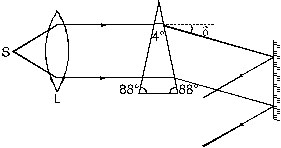
Sol.

15. Located the image formed by refraction in the situation shown in figure. The point C is the centre of curvature.
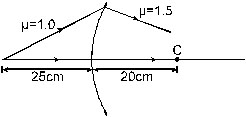
Sol.
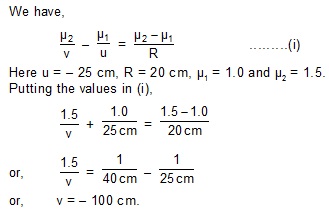
As v is negative, the image is formed to the left of the separating surface at a distance of
100 cm from it.
16. One end of a horizontal cylindrical glass rod (µ = 1.5) of radius 5.0 cm is rounded in the shape of a hemisphere. An object 0.5 mm high is placed perpendicular to the axis of the rod at a distance of 20.0 cm from the rounded edge. Located the image of the object and find its height.
Sol. Taking the origin at the vertex, u = – 20.0 cm and R = 5.0 cm.
We have,
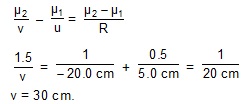
The image is formed inside the rod at a distance of 30 cm from the vertex.

![]()
Thus, the image will be of same height (0.5 mm) as the object but it will be inverted.
17. There is a small air bubble inside a glass sphere (µ = 1.5) of radius 10 cm. The bubble is 4.0 cm below the surface and is viewed normally from the outside. Find the apparent depth of the bubble.
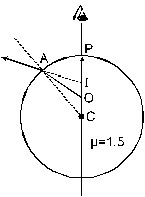
Sol. The observer sees the image formed due to refraction at the spherical surface when the light from the bubble goes from the glass to the air.
We have,
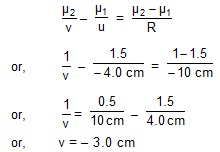
Thus, the bubble will appear 3.0 cm below the surface.
18. A parallel beam of light travelling in water (refractive index = 4/3) is refracted by a spherical air bubble of radius 2 mm situated in water. Assuming the light rays to be paraxial, (i) find the position of the image due to refraction at the first surface and the position of the final image, and (ii) draw a ray diagram showing the positions of both the images.
Sol. The ray diagram is shown in figure. The equation for refraction at a spherical surface is
.jpg)

The negative sign shows that the image I1 is virtual and forms at 6 mm from the surface of the bubble on the water side. The refracted rays (which seen to come from I1) are incident on the farther surface of the bubble. For this refraction,
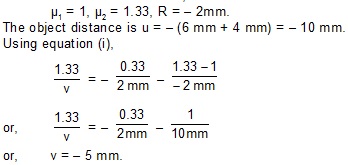
The minus sign shows that the image is formed on the air side at 5 mm from the refracting surface.
Measuring from the centre of the bubble, the first image is formed at 8.0 mm from the centre and the second image is formed at 3.0 mm from the centre. Both images are formed on the side from which the incident rays are coming.
19. Calculate the focal length of the thin lens shown in figure. The points C1 and C2 denote the centres of curvature.
Sol. As is clear from the figure, both the radii of curvature are positive. Thus, R1 = + 10 cm and
R2 = + 20 cm. The focal length is given by

20. A point source S is placed at a distance of 15 cm from a converging lens of focal length 10 cm on its principal axis. Where should a diverging mirror of focal length 12 cm be placed so that the real image is formed on the source itself.
Sol. The equation for the lens is
![]()
.jpg)
The positive sign of v shows that the image I1 is formed to the right of the lens in the figure. The diverging mirror is to be placed to the right in such a way that the light rays fall on the mirror perpendicularly. Then only the ray will retrace their path and form the final image on the object. Thus, the image I1 formed by the lens should be at the centre of curvature of the mirror.
We have, LI1 = 30 cm.
MI1 = R = 2F = 24 cm.
Hence LM + LI – MI1 = 6 cm.
Thus, the mirror should be placed 6 cm to the right of the lens.
21. A converging lens of focal length 15 cm and a converging mirror of focal length 20 cm are placed with their principal axes coinciding. A point source S is placed on the principal axis at a distance of 12 cm from the lens as shown in figure. It is found that the final beam comes out parallel to the principal axis. Find the separation between the mirror and the lens.
Sol. Let us first located the image of S formed by the lens. Here u = – 12 cm and f = 15 cm.
We have,

The negative sign shows that the image is formed to the left of the lens as suggested in the figure. The image I1 acts as the source for the mirror. The mirror forms an image I2 of the source I1. This image I2 then acts as the source for the lens and the final beam comes out parallel to the principal axis. Clearly I2 must be at the focus of the lens.
We have,
I1I2 = I1P + PI2 = 60 cm + 15 cm = 75 cm.
Suppose the distance of the mirror from I2 is x cm. For the reflection from the mirror,
u = MI1 = – (75 + x) cm, v = – x cm and f = – 20 cm.
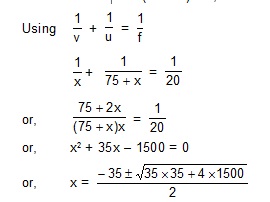
This gives x = 25 or – 60.
As the negative sign has no physical meaning, only positive sign should be taken. Taking
x = 25, the separation between the lens and the mirror is (15 + 25)cm = 40 cm.
22. A biconvex thin lens is prepared from glass (µ = 1.5), the two bounding surfaces having equal radii of 25 cm each. One of the surface is silvered from outside to make it reflecting. Where should on object be placed, before this lens so that the image is formed on the object itself?
Sol. Refer to figure. The object is placed at O. A ray OA starting from O gets refracted into the glass at the first surface and hits the silvered surface along AB. To get the image at the object, the rays should retrace their path after reflection from the silvered surface. This will happen only if AB falls normally on the silvered surface. Thus, AB should appear to come from the centre C2 of the second surface. Thus, due to the refraction at the first surface, a virtual image of O is formed at C2. For this case,
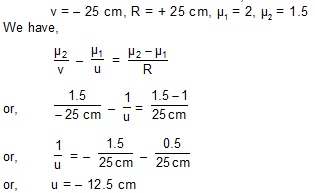
Thus, the object should be placed at a distance of 12.5 cm from the lens.
23. A concavo-convex (figure) lens made of glass (µ = 1.5) has surfaces of radii 20 cm and 60 cm. (a) Locate the image of an object placed 80 cm to the left of the lens along the principal axis. (b) A similar lens is placed coaxially at a distance of 160 cm right to it. Locate the position of the image.
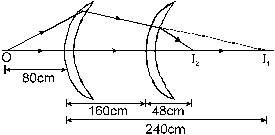
Sol. The focal length of the lens is given by

The first image I1 would form 240 cm to the right of the first lens.
(b) The second lens intercepts the converging beam as suggested by the figure. The image I1 acts as a virtual source for the second lens. For the image formed by this lens, u = 240 cm – 160 cm = + 80 cm so that
![]()
or, v = 34.3 cm.
The final image is formed 34.3 cm to the right of the second lens.
24.
Sol. 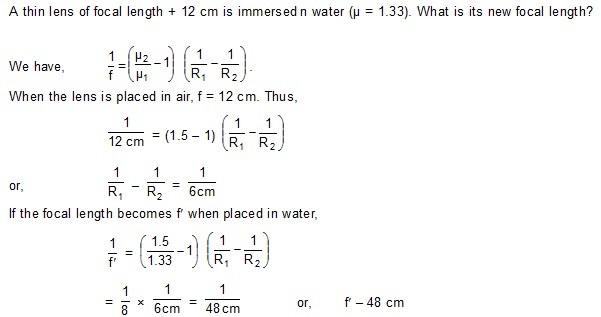
25. A long cylindrical tube containing water is closed by an equiconvex lens of focal length 10 cm in air. A point source is placed along the axis of the tube outside it at a distance of 21 cm from the lens. Located the final image of the source. Refractive index of the material of the lens – 1.5 and that of water = 1.33.
Sol. The light from the sources S gets refracted at the air-glass interface and then at the glass-water interface. Refracting to the figure, let us take vertically downward as the positive direction of the axis.
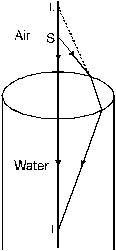
If the image due to the refraction at the first surface is formed at an image - distance v1 from the surface,
we have,

where R is the radius of curvature of the surface. As the lens is equiconvex, the radius of curvature of the second surface is – R. Also, the image formed by the first surface acts as the object for the second surface. Thus,
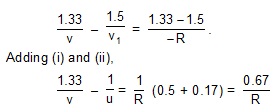
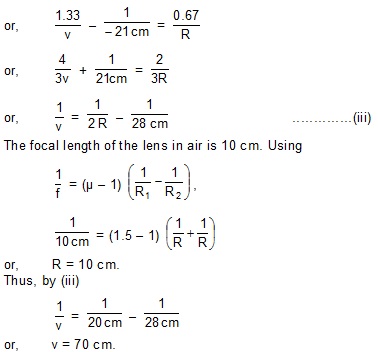
The image is formed 70 cm inside the tube.
26. A slide projector produces 500 times enlarged image of a slide on a screen 10 m away. Assume that the projector consists of a single convex lens used for magnification. If the screen is moved 2.0 m closer, by what distance should the slide be moved towards or away from the lens so that the image remains focused on the screen? What is the magnification in this case?
Sol.
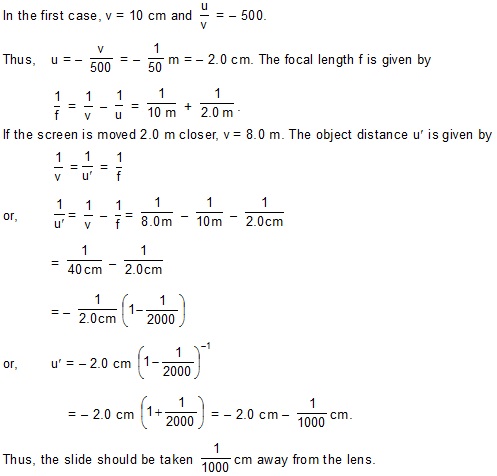
27. A convex lens focuses a distant object on a screen placed 10 cm away from it. A glass plate (µ = 1.5) of thickness 1.5 cm is inserted between the lens and the screen. Where should the object be placed so that its image is again focused on the screen.
Sol. The focal length of the lens is 10 cm. The situation with the glass plate inserted is shown in figure. The object is placed at O. The lens would form the image at I1 but the glass plate intercepts the rays and forms the image at I on the screen.
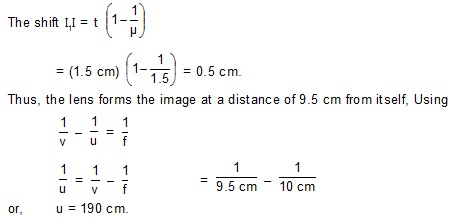
28. Two convex lenses of focal length 20 cm each are placed coaxially with a separation of 60 cm between them. Find the image of a distant formed by the combination by (a) using this lens formula separately for the two lenses and (b) using the equivalent lens. Note that although the combination forms a real image of a distance object on the other side, it is equivalent to a diverging lens as far as the location of the final image is concerned.
Sol. (a) The first image is formed at the focus of the first lens. This is at 20 cm from the first lens and hence at u = – 40 cm from the second. Using the lens formula for the second lens,
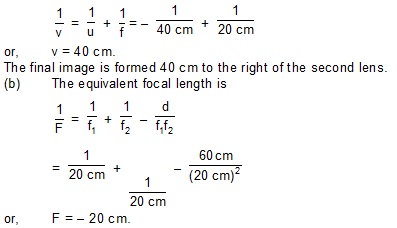
It is a divergent lens. It should be kept at a distance

Thus, the equivalent divergent lens should be placed at a distance of 60 cm to the right of the second lens. The final image is formed at the focus of this divergent lens i.e., 20 cm to the left of it. It is, therefore, 40 cm to be right of the second lens.